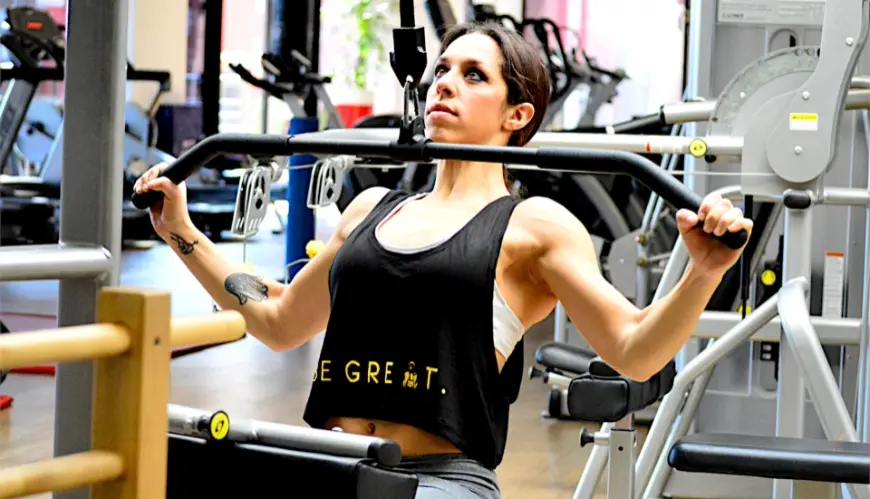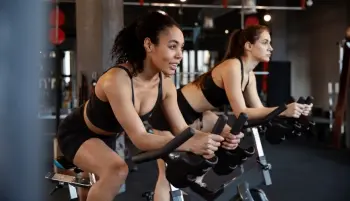Focus: Back, Shoulders
Required Equipment: Resistance band, light free weights, or a cable pulley mechanism
Difficulty Level: Novice
The pulldown action exercise primarily targets the muscles in your back. The exercise is performed on an adaptable resistant workstation which typically utilizes weight plates.
During execution of this movement while you are seated, you draw down a suspended bar towards yourself until it reaches the level of your chin. Afterward, in a controlled manner, return the bar to its original position for one complete cycle. This physical action can be integrated into routines that aim at strengthening upper body muscles.
Performing a Lat Pulldown Properly
Take a seat on the pulldown machine, ensuring your feet are completely grounded. Assess the bar's elevation- you might need to adjust its level by increasing or decreasing the chain or cable's length that holds up the bar, or modify your sitting position. If you're uncertain about how to do it appropriately, enlist help from a fitness instructor.
The ideal height is one where you can grip effortlessly with your arms extended without standing fully straight but still have sufficient stretch for complete body movement. If there's an adjustable thigh support present, ensure it fits snugly under your upper thighs as this will aid when pulling down against resistance.
- Start by holding onto the bar using an overhand grip (knuckles facing skywards) and make sure to spread out wide apart. While alternative grips may also be used eventually, stick with this basic formation initially.
- Next, lower down until around chin-level while exhaling during descent. A minimal leaning back is acceptable but try keeping your upper torso stable throughout by grounding both feet and activating those abdominals during pull downs. Consider full range achieved when it no longer feels feasible moving downwards any further without pushing backwards – refrain from extending beyond this point. 3a Hold shoulder blades together tightly but keep shoulders relaxed into their sockets, 3b After reaching till almost touching chin with bars in bottom-most stance gradually start releasing upwards controlling speed of rise so doesn't bounce against weight stacks excessively 4 Keep repeating process till desired number both sets reps completed before pausing prior continuing routine
Advantages of Lat Pulldowns
Lat pulldowns are an impactful exercise that primarily affects the latissimus dorsi, or the "lats." Located beneath your armpits and spreading downwards across your back, focusing on these muscles can help strengthen them without exhausting other muscle groups such as biceps and triceps.
Focusing on your back muscles is crucial in maintaining correct posture and assisting with pulling movements in everyday life. Activities like opening a door, initiating a lawnmower's motion, swimming sessions, or carrying out pull-ups can benefit from robust lats. Furthermore, they might even aid in alleviating certain types of back discomfort.
Daily Weight Lifting: Body Changes You Can Expect
Alternative Versions of Lat Pulldowns
You have the flexibility to carry out this workout in various manners that suit your competencies and objectives.
Exercise Types for Neophytes: Bands or Light Weights
Novices could consider starting with light weights or a band so they can maintain proper posture during exercises. Another approach is to try doing the workout while standing and positioning one leg as if in mid-stride.
Different Grip Styles
Experiment with wider, narrower, underhand or overhand grips for engaging different muscle groups. When you opt for a medium-width grip keeping your forearms vertical and hands approximately at shoulder distance, it stresses the biceps and central back region. Broadening your grip engages more muscles in the back, while a narrow-grip pulldown focuses on strengthening forearm muscles.
Straight Arm Pulldown Exercise
The straight arm pulldown workout involves maintaining your elbows practically completely extended throughout the exercise (commonly performed standing). It primarily targets the muscles located on the upper arm's backside - essentially known as the triceps.
Changing Your Hold Position
Switching your hold to an underhand style, with the knuckles facing downwards and palms facing upwards, concentrates additional effort on the anterior muscles of your upper arm - specifically your biceps.
You have the option to modify your hold in any section along the bar - be it wide, middle or close.
Leg Press Guide: Methods, Advantages & Variations
Typical Blunders
Steer clear from these blunders to fully benefit from this activity and shield yourself against wear and tear or harm.
Curving Your Spine
Stay seated upright and elevate your chest while pulling down the bar. Safeguarding the neutrality of your spine helps to shield your lower back from harm.
Leveraging Your Forearms
Ensure that your forearms aren't carrying out the task of pulling down the bar. The action should stem from your back muscle strength. Engage your lats through initiating a pull-down movement at the underarm level.
Grasping the Bar Excessively Broad
Ensure you hold onto the bar slightly wider than your shoulder width but avoid it being extremely wide, particularly if you're a novice. Maintain your elbows oriented downwards when lowering the bar not towards either side.
Taking the Pull Down Too Low
Cease at the instant when to proceed with pulling down the cable, your elbows ought to move in a reverse direction. Overstressing of the shoulder joint might occur if the elbows try to navigate backward. You are advised to only bring down the bar up until it reaches your chin or slightly beneath that point.
Deploying Momentum
Similar to the majority of resistance workouts, execute the pulldown gradually and in a controlled manner. Rapid movements utilize momentum, which diminishes engagement of the intended muscles.
Measures for Protection and Precaution
The neck-adjacent pulldown is generally not suggested due to safety concerns. There's potential risk of harm because of shoulder joint rotation and the bar possibly mingling with your spine.
Should you have issues with your wrist, elbow, or shoulder, it's advisable to consult either your doctor or physiotherapist to determine if this exercise is safe for you. Immediately halt this workout if you feel discomfort or too much stress on any part of your shoulder joints.
The quantity of repetitions that can be included in a single session depends on factors like the weight being lifted, your level of training experience as well as overall muscle power.
Give It a Go
Merge this maneuver and comparable ones into any of these commonly done workouts:
- Push-pull resistance training session
- Full body tri-set strength exercise
- Back and abdomen fortifying routine
Commonly Posed Inquiries
-
Which muscles are targeted by lat pulldowns?
Lat pulldowns majorly engage the back muscles, primarily focusing on the broad and flat latissimus dorsi muscle group, often simply referred to as the "lats".
-
Which is more effective: lat pulldowns or pull-ups?
As a replacement to pull-ups for those still enhancing their strength level, lat pulldowns make an excellent choice. Even though pull-ups edges out in terms of fostering power, lat pulldowns provide added flexibility with adjustable weights. Notwithstanding this difference, both these workouts significantly cater to your back muscles.
-
Is lat pulldown workout meant for shoulders or back?
Primarily, doing lat pulldown targets your backend muscular frame. The large-sized 'latissimus dorsi' muscle that spans across either side of your rear towards your hip region derives maximum benefit from it.
-
Does grip width affect effectiveness in a lat pulldown exercise?
Grip positioning does not have significant impact while performing this activity. One can keep hand hold broader apart or closer together; either way effectively hones ones lats. Wider hand holding may tend to apply more stress on lats compared to narrow style which energize your rhomboids and trapezius musculature.




